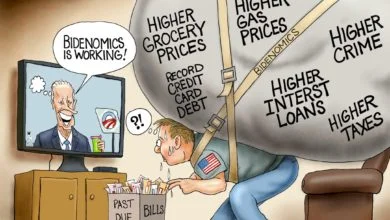Congressional Effort To Rein In Deficit Ends in Failure – Again
By Dustin Siggins
Congress’s most recent failure to act on budget process reforms will likely result in a huge increase in the national debt an analysis of available data suggests.
Congress recently failed again to reform budget processes to slow the nation’s growing national debt. A bipartisan committee created in the spring 2018 budget deal was supposed to end the budget tumult of the last few years, which included numerous partial government shutdowns and missed budget deadlines.
However, members failed to approve a series of reforms such as moving to two-year budgets, tightening spending limits, and ending a tradition of adding irrelevant amendments to spending bills were withdrawn, ignored, or voted down.
Only seven out of 16 members—all Republicans— of the Joint Select Committee on Budget and Appropriations Process Reform voted for changes. Two Democrats opposed it, while six Democrats and one Republican abstained.
With this vote, House Speaker Ryan and other Republicans appear to have again broken promises to rein in spending. Republicans championed fiscal discipline under President Barack Obama. Democrats have done the same under President Donald Trump. Both parties, have backed massive increases in federal spending which have increased deficits.
Ryan’s office did not respond to an e-mailed request for comment on this story.
This isn’t the first time that a federal commission to reform federal budgeting processes and spending limits has failed. Ryan opposed recommendations by a 2010 committee’s chairmen to trim spending because the recommendations didn’t cut enough money and didn’t do enough to affect the then-new Affordable Care Act law. The chairmen recommendations would have trimmed four trillion dollars from expected deficits over a decade.
Yet as Speaker, Ryan has done very little to slow or reverse course on spending.
Jonathan Bydlak, president of the Institute for Spending Reform, told AMI Newswire that the failed efforts of 2010 and 2018 have one thing in common. “Political courage…was in short supply once politicians had a real chance to make tough choices,” he said.
The Deficit and Debt March On
The latest failure at budget reform means Americans will continue to feel the pain from slower economic growth due to the rising national debt. A 2014 working paper from the Congressional Budget Office:
“Increases in federal budget deficits affect the economy in the long run by reducing national saving (the total amount of saving by households, businesses, and governments) and hence the funds that are available for private investment in productive capital… Lower output and lower national saving lead to a lower standard of living for U.S. households than would otherwise be the case.”
Additionally, “deficit spending today means tax increases in the future,” said The Heritage Foundation’s Adam Michel in an interview with AMI Newswire.
The national debt in 2010 was $13.6 trillion, according to the U.S. Treasury Department. Today, it is $21.5 trillion. Comparatively, the U.S. Gross Domestic Product (GDP) was $14.96 trillion in 2010 and is projected to reach $20.1 trillion by the end of this month. These nominal dollar comparisons show that the debt is increasing much faster than GDP. This is the federal equivalent of a household bringing in a higher salary while spending more than that salary can cover.
Revenues have grown faster than inflation but, spending grew six times faster than ever. Tax revenues have increased 3% points due to the GOP tax reforms but, spending far outstripped the gains — rising 18%. In October and November spent $303 billion more than it took in or more than 101 billion more than the same period the year prior according to the CBO.
The think tank Just Facts found that the U.S. federal government’s “debts, liabilities, and unfunded obligations” – in other words, looking not just year-to-year but decades into the future – paint a worsening financial picture. These nominal costs went from $513,380 per U.S. household in 2011 to $704,391 per household in 2017.
“The figures…are determined in a manner that approximates how publicly traded companies are required to calculate their debts, liabilities, and unfunded obligations,” Just Facts reports. “They are likely low, because the Board of Medicare Trustees has stated that the program’s long-term costs may be “substantially higher” than projected under current law. This is because current law includes the effects of the Affordable Care Act, which will cut Medicare prices for ‘many’ healthcare services to ’less than half of their level’ under prior law.”
Source: American Media Institute




